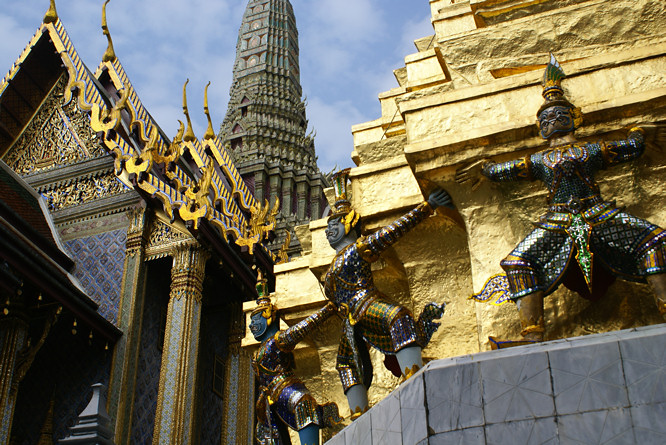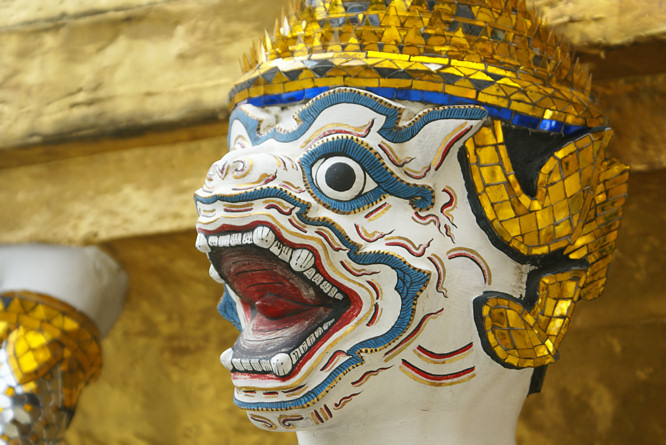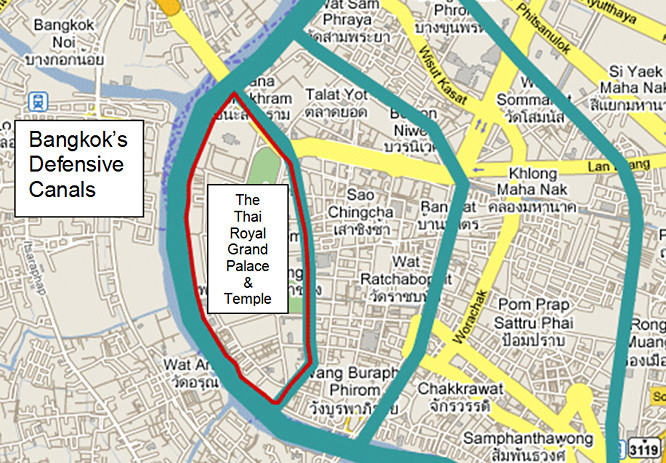History of the Bangkok Thai Royal Grand Palace
The old historic area of Bangkok is called Rattanakosin. It is situated on the bend in the Chao Phraya river on the east bank. It includes the Royal Thai Grand Palace and numerous magnificent temples. Rattanakosin is the oldest district of Bangkok, established in 1782 by King Rama I.

It became the new capital of Siam (Thailand) because the old capital, Ayutthaya which is north of Bangkok, burned to the ground by the Burmese army. The Kingdoms of Siam in the south and Burma in the north had been at war for many years.
The original palace was built entirely of wood. King Rama I held a brief victory coronation on 10 June. Three days later, a formal coronation ceremony was held, on 13 June, 1782. This date was used to mark the start of the Royal Chakri Dynasty.
The Thai Royal Grand Palace was built on land once occupied by Chinese merchants. They settled slightly downriver from the Grand Palace, in an area called Sampeng, which is where Bangkok's Chinatown. Under King Rama II, the Grand Palace grounds were expanded southward to a total area of 244,000 square meters. The palace is surrounded by a tall white fortification wall with watch towers.

King Taksin the Great of Siam and 1767
As already mentioned Siam (Thailand) and Burma were constant enemies. During final major offensive by the Burmese in 1767 they surrounded the island where the Siam ancient capital of Ayutthaya was built. After fierce fighting, the Burmese burned and destroyed all the buildings in Ayutthaya. The Siamese would have been totally annihilated if not for a Siamese general Taksin. He was of Chinese Teochew extraction. With some of his men he escaped from Ayutthaya.
He regrouped and formed a new Siam army. Seven months after the fall of Ayutthaya, general Taksin forced out the Burmese from Ayutthaya. The capital city was destroyed beyond recovery. Taksin then established a new Siamese capital at Thonburi (Bangkok), on the west bank of the Chao Phraya River across from where Rattanakosin is located, and had himself crowned the new king of Siam.
Under King Taksin, Siam grew even bigger than its size when its old capital at Ayutthaya fell. Having made the Burmese retreat, he brought the whole of the Chao Phraya river basin under his rule. In 1769, he occupied western Cambodia. Then King Taksin moved south to re-establish Siamese rule over much of the Malay Peninsula, as far as what is now Penang on the west coast, and Terengganu on the east. In 1774, his army pushed north and took Chiang Mai from the Burmese and captured Vientiane, putting Laos under Siamese control.
King Taksin's reign ended after 15 years, when he was removed from the throne after he was declared insane and executed in a coup d'etat. Today, Thai people look back on his reign with respect, and appreciate what he had done. For that reason, he is officially titled King Taksin the Great.

General Chao Phraya Chakri - King Rama I of Siam
King Taksin's successful general Chao Phraya Chakri was away fighting in Cambodia at the time of the coup and execution. He hurried back to Bangkok. The coup plotters surrendered to him, and offered him the throne of Siam. He accepted the crown and became known as King Rama I, from him began the Chakri Dynasty that continues to this day
Being a military man one of the first things King Rama I did was to move the capital, from Thonburi on the west bank across the river to Rattanakosin. To strengthen the defences of Rattanakosin King Rama I, turned it into an island. As it is located on a curve of the meandering Chao Phraya River, he dug two defensive rings of canals to protect his capital, and fortified them with fortresses. Sumen Fort and Mahakan Fort are the only two remaining canal fortresses out of the original fourteen that were built
These canal rings still exist today, and can be seen on maps of Bangkok. The inner one is called Khlong Lord, part of it has been filled up. The outer canal comprises of two water ways one called Khlong Banglamphu and the other Khlong Ong Ang. Later on, the third ring canal, Khlong Phadung Krungkasem, was added. Additional canals were added, both on the east as well as west sides of the Chao Phraya. Until Charoen Krung Road was paved in 1861, the majority of Bangkok's population lived a semi-amphibious life, in huts on rafts or on stilts. Only Rattanakosin was permanently dry.
King Rama IV 1851-1868
The city of Bangkok, now at peace, gradually grew in size as trade increased. During King Mongkut's reign, Rama IV (1851-1868), the shape and face of the city began to change drastically. He was a brilliant leader who deftly negotiated treaties with foreign powers to prevent foreign colonization. However, he also opened the country up to trade and its beneficial effects.
Foreigners, arrived and expanded the horizons of Thai merchants as well as their bank balances. By 1860 many European countries and North America had struck trade treaties with Bangkok, the port had been expanded and in 1863 the city's first paved streets were built. Mass migration from the declining farming heartland, resulted in a massive urbanisation of the city and a lot of haphazard town planning.
King Rama V 1868-1910
When King Chulalongkorn, Rama V (1868-1910), took over he continued apace with his father's reforms. The building of roads, construction of Thailand's first railroad to the north and the addition of a tramline were just some of the projects he implemented. The foundations for the modern Thai government were laid down.
Religious freedom was declared, allowing Christianity and Islam to be practiced in a devoutly Buddhist country. And the large Chinese population were forced to assimilate into mainstream Thai society by being forced to adopt Thai surnames, so reducing racial tensions and violent crime.
The 1932 revolution
Although the seat of the Monarchy has been in Bangkok for two centuries or more, they haven't always been present. One of many coups to be launched in the city was the 1932 overthrown of absolute monarchy by a group of Paris-based students who had brought democratic ideas back with them. Although a constitutional monarchy was permitted, King Prajadhipok (Rama VII) later resigned and left a vacuum from 1935 to the end of WWII.
WW2 Thailand joins sides with the Japanese
During the Second World War, a puppet government under military ruler Phibul Sonkhram ruled Thailand from Bangkok. That government sided with the Japanese early in the war in order to maintain their own personal grip on power. This was to cost the country dearly at the end of the war, when the Allies demanded war compensation.
The Vietnam War and Modernisation
The Vietnam War marked a major period of change in the history of Bangkok as money poured into the country from America and improvements were made to the city's infrastructure. Since that time Bangkok has grown into a thriving metropolis, spreading over 1,568 square kilometres, consisting of some 50 districts and is home to one-tenth of the total population of Thailand - some eight million people.
Bangkok - What does it mean?
The name 'Bangkok' formerly referred to a small fishing village which later expanded into communities on both sides of the Chao Phraya River. The Thai word 'Bang' refers to a village The word 'makok' in Thai means wild olive groves which was shortened to 'kok'. So Bangkok means the village full of wild olive groves.
Travel books

